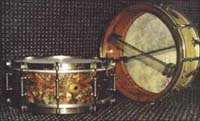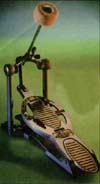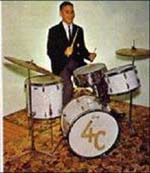
THE HISTORY OF DRUMSET
The modern drumset was not invented by one individual at one particular time or place. It evolved during the early part of the 20th century, with contributions by both musicians and instrument makers. By the 1890's, drummers in New Orleans (and elsewhere) were adapting the drums of the traditional military-style marching band to the stage, placing snare and bass drums so that both could be played by one player. At the same time, New Orleans musicians were developing a style of playing based on collective improvisation, later known as Jazz. In 1909, drummer and instrument maker William F. Ludwig produced the first practical bass drum pedal. Although other mechanisms, controlled by foot or by hand, had existed for some years, Ludwig's pedal allowed the bass drum to be played more quickly and easily with the foot, freeing the player's hands to concentrate on the snare drum and other instruments.
By 1920, a New Orleans drummer (such as Baby Dodds or Zutty Singleton) might be playing a set consisting of bass drum (possibly with attached cymbal and "clanger"), snare drum, Chinese tom-tom (with tacked-on heads), woodblock, cowbells, and small Chinese cymbals. Similar sets (often with the addition of sirens, whistles, birdcalls, air horns, etc.) were utilized by drummers playing for Vaudeville revues, circuses, and other theatrical performances. These were commonly referred to as "traps", a term generally thought to derive from "contraption" (but possibly from "trappings", according to James Blades in the Grove Dictionary of Musical Instruments). In the early part of the 1920's, the "snowshoe" or "Charleston" foot pedal was making an appearance on the bandstand. This invention consisted of a hinged pair of foot-sized boards with small cymbals attached. Around 1925 drummers began using a "low boy" or "sock cymbal", a pair of small cymbals mounted on a low, spring-equipped stand operated by the foot. Around 1927, the first "high boys", or "high hat" cymbal stands appeared, enabling the drummer to play the cymbals with either the foot or the hands, or a combination of both (as mastered by drummers like Chick Webb and Jo Jones).
Throughout the 1930's and 1940's, drum manufacturers further refined and developed components of the set to meet the requirements of popular drummers such as Jo Jones and Gene Krupa, making larger tom-toms, "floor" toms, sturdier drum-mounted cymbal stands, and faster bass drum pedals. In the mid-1940's, the advent of bebop necessitated changes in drumming if not in the drumset itself. The quicker, more fluid melodic and harmonic style pioneered by Dizzy Gillespie and Charlie Parker was paralleled by the development of a more melodic and independent rhythmic concept, exemplified by the innovations of drummers like Kenny Clarke, Max Roach and Art Blakey. Bass drums were a little smaller, cymbals a little larger, but the drumset of the swing era remained essentially unchanged. The drumset began growing again in the early 1950's with the addition of a second bass drum by Louie Bellson and others. In the late 50's, "Chick" Evans and Remo Belli each developed new plastic drumheads, freeing drummers from the weather-sensitive quirks of calfskin. To support (or compete with) the amplified guitar sound of the 60's, rock drummers moved once again toward deeper and heavier drums. The trend toward larger drumsets grew to outrageous proportions in the 70's as drummers added more toms and cymbals than any human could possibly play.
|
HOME | HISTORY | DRUMSET | DRUMSTICK | TUTORIAL | SCORES | LINKS | COMMENTS
© Clement Li, Department of Communication,
Western Michigan University
Kalamazoo, Michigan, USA.
Last Update: Jun 23, 2002.
Contact
Me



